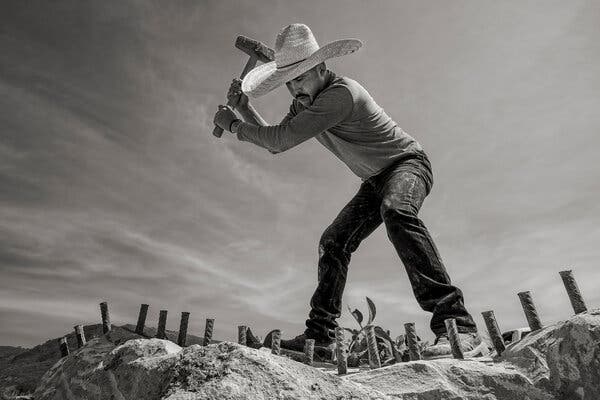The small town of Escolásticas, built on ancient volcanic stone, carves a ragged path through a high desert hillside in Central Mexico. Three hours northwest of Mexico City, this community of 3,000 people is surrounded by razor-sharp cactuses, like the nopal, and sun-scorched desert trees, like the palo dulce. Travelers could easily pass through the place without noticing more than its potholes and weathered storefronts.
On closer inspection, there’s much more to see.
There are perhaps 200 stone-carving workshops in Escolásticas, all small and open air. Around 300 of the local men work in these shops as artisan stone carvers, and refer to their finished work as “cantera,” a word derived from the Spanish word for “quarry.” (“Cantera” is also a generic term for a type of soft stone used in hand-carved columns, moldings and other architectural features.)
Astoundingly, few people throughout the world know this place exists.
The artisans in Escolásticas are heirs to a tradition of stone sculpting that extends back several millennia.
Some 3,000 years ago, sculptors working among the Olmecs — widely regarded as the first elaborate pre-Columbian civilization in Mesoamerica — mastered the art of carving the human form. More than 2,000 years later, the Aztecs were producing large stone sculptures that often borrowed from Olmec designs.
That sense of shared inspiration continues to this day.
I first visited Escolásticas in January 2020, while searching with friends for story ideas about compelling and overlooked subjects. I had never seen an industrial landscape so consumed with small workshops — along with chunks of volcanic stone, cantera sculptures, clouds of dust and a high desert sun that seemed to scream more than it shined.
One hundred years ago, haciendas and churches in the area needed stone cut for walls, steps and tile. Locals figured out how to do it, and slowly the quality of the art began to evolve.
Today, you can buy carvings directly from artists, and the cantera from Escolásticas is exported all over Mexico and the United States.
Unaided by computers and other modern technologies, carvers draw a basic shape on the stone, and then bring that shape to life using electric grinding tools, hammers, chisels and, finally, sandpaper. They eyeball a chunk of the volcanic rock, remove what they do not need, and carve animals, archangels, fountains, fireplace facades, and other almost countless designs.
When I asked a carver named Francisco Maldonado what he could make, he replied: “I can make anything, señor. What would you like today?”
Stone carving is the dominant profession in Escolásticas. Even children will pick up a small hammer and strike it to a stone. Older mentors teach younger students to carve, and so the tradition continues.
Many of the carvers, I am told, die young from breathing the stone dust. Hardly any sign or identify their art. In a way, anonymity is an inherited and accepted fate.
Aaron Camargo Evangelista, 29, lives in a red brick, two-room shack, just beside the road through town. He could throw a feather from his pillow and hit the trucks that drive by in the night. When Margo, my interpreter, and I first met him, he was standing next to the road carving a stunningly detailed nine-foot-tall raven.
I asked if he had considered showing his work on Facebook or Instagram.
“I am not intelligent enough,” he said, as if his sculpture weren’t proof of an astounding intellect.
Rubén Ortega Alegria, 50, said he finds inspiration in the drawings of Michelangelo. His 10-year-old son, José Juan Ortega Contreras, also wants to carve. During one of my visits, José walked to his father’s open-air workshop after school to watch and learn. His father picked a moment to guide his son’s hands over the stone, so he could feel the life inside.
“You need to touch it and feel it move,” he explained. “You need to know it before you can carve it.”
Alejandro Camargo is a master carver. An accident he suffered at the age of 17 left him unable to perform other heavy work, and so he turned to carving. Now 60, he relies on his sons to help him move the heavy stone, which he brings to life. He is referred to by the other local sculptors as “Maestro.”
I asked if he talks to the stone. “Of course,” he said. “I ask the stone, ‘What do you want to be?’ And the stone speaks to me. We are friends. I listen to the stone.”
Walter Hodges is a photographer based in San Miguel de Allende, Mexico. You can follow his work on Facebook and via his blog.
Follow New York Times Travel on Instagram, Twitter and Facebook. And sign up for our weekly Travel Dispatch newsletter to receive expert tips on traveling smarter and inspiration for your next vacation. Dreaming up a future getaway or just armchair traveling? Check out our 52 Places list for 2022.


























